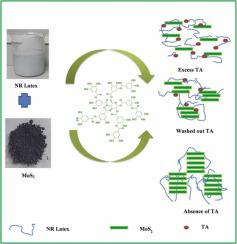Industrial Crops and Products ( IF 5.6 ) Pub Date : 2022-11-29 , DOI: 10.1016/j.indcrop.2022.115978 A.S. Sethulekshmi , Appukuttan Saritha , Kuruvilla Joseph , Abi Santhosh Aprem , Suja Bhargavan Sisupal , G Sidharth , Vidhu S Nair

|
Exfoliating agents play a vital role in the dispersion of nanofillers in polymer matrices. The choice of exfoliating agent is a crucial step in the design and synthesis of nanocomposites. The use of bio based exfoliating agents is considered benign for extending the applications of nanocomposites in biomedical systems. The present work discusses the role of a green exfoliating agent, tannic acid (TA), in the formation of natural rubber (NR) - molybdenum disulfide (MoS2) nanocomposites. MoS2 was exfoliated in the absence and presence of tannic acid and the role of the exfoliating agent on the performance of the nanocomposite system was carefully evaluated. The effect of excess exfoliating agent in the system was also monitored by washing out the excess tannic acid and analyzing the properties of nanocomposites. Fourier transform infrared spectroscopy (FT-IR), X-ray diffraction (XRD), transmission electron microscopy (TEM), Raman and thermogravimetric analysis (TGA) were carried out to characterize the TA assisted MoS2 nanosheets. The exfoliated MoS2 (in the absence of TA, excess of TA and after washing out) was then successfully inserted into NR latex and NR-MoS2 nanocomposites were prepared through latex dipping method. In the absence of washing out, the existence of excess tannic acid in the system promoted effective exfoliation leading to enhanced mechanical and thermal properties. However, upon washing out the excess tannic acid, the properties were less than that of the non-washing out system but greater than that of the system devoid of tannic acid. The current study clearly illustrates the dual function of a biomaterial like tannic acid as an exfoliating and reinforcing agent and showcases a green pathway towards the synthesis of natural rubber nanocomposites.
中文翻译:

单宁酸作为绿色去角质剂:开发天然橡胶-二硫化钼纳米复合材料的可持续途径
去角质剂对纳米填料在聚合物基质中的分散起着至关重要的作用。去角质剂的选择是纳米复合材料设计和合成的关键步骤。生物基去角质剂的使用被认为有利于扩展纳米复合材料在生物医学系统中的应用。目前的工作讨论了绿色去角质剂单宁酸 (TA) 在天然橡胶 (NR) - 二硫化钼 (MoS 2 ) 纳米复合材料形成中的作用。二硫化钼在不存在和存在单宁酸的情况下被剥离,并且仔细评估了剥离剂对纳米复合材料系统性能的作用。系统中过量去角质剂的影响也通过洗掉过量的单宁酸和分析纳米复合材料的性质来监测。进行傅立叶变换红外光谱 (FT-IR)、X 射线衍射 (XRD)、透射电子显微镜 (TEM)、拉曼和热重分析 (TGA) 以表征 TA 辅助的 MoS 2纳米片。然后将剥离的 MoS 2(在没有 TA、过量 TA 和洗掉后)成功地插入到 NR 胶乳和 NR-MoS 2中采用乳胶浸渍法制备纳米复合材料。在没有洗掉的情况下,系统中过量单宁酸的存在促进了有效的剥离,从而提高了机械和热性能。然而,在洗掉过量的单宁酸后,性能低于非洗掉系统的性能,但高于不含单宁酸的系统的性能。目前的研究清楚地说明了单宁酸等生物材料作为去角质剂和增强剂的双重功能,并展示了合成天然橡胶纳米复合材料的绿色途径。











































 京公网安备 11010802027423号
京公网安备 11010802027423号